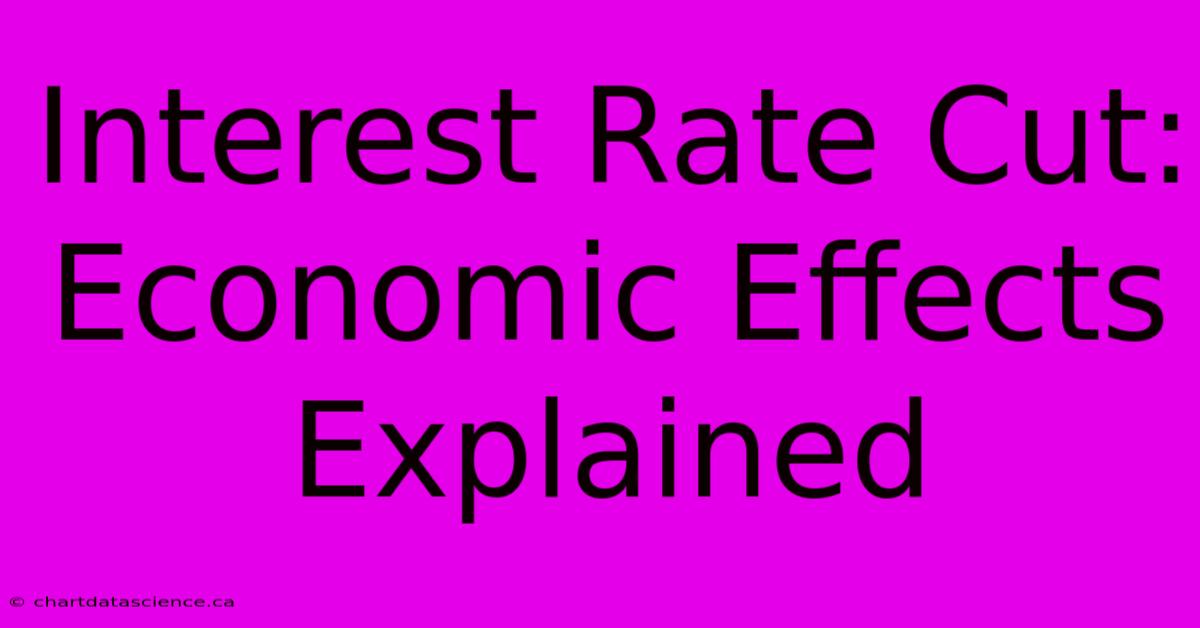Interest Rate Cut: Economic Effects Explained

Discover more detailed and exciting information on our website. Click the link below to start your adventure: Visit My Website. Don't miss out!
Table of Contents
Interest Rate Cut: Economic Effects Explained
An interest rate cut, a seemingly simple monetary policy tool, ripples through an economy with far-reaching consequences. Understanding these effects is crucial for businesses, investors, and individuals alike. This article will dissect the economic impacts of an interest rate cut, exploring both the intended and unintended outcomes.
What is an Interest Rate Cut?
Simply put, an interest rate cut is a reduction in the target rate set by a central bank, such as the Federal Reserve (Fed) in the US or the European Central Bank (ECB). This target rate influences other interest rates throughout the economy, including borrowing rates for businesses and consumers. When the central bank lowers its rate, it becomes cheaper for banks to borrow money, and this lower cost is typically passed on to borrowers.
Intended Effects of an Interest Rate Cut: Stimulating the Economy
Central banks typically implement interest rate cuts to stimulate economic growth during periods of economic slowdown or recession. The intended effects are multifaceted:
1. Increased Borrowing and Spending
Lower interest rates make borrowing cheaper. Businesses are more likely to invest in expansion, equipment upgrades, and hiring. Consumers are encouraged to borrow more for large purchases like houses and cars, boosting consumer spending. This increased borrowing and spending fuels economic activity.
2. Investment Stimulation
Lower borrowing costs make it more attractive for businesses to invest in new projects and expand their operations. This increased investment can lead to job creation and increased productivity, contributing to long-term economic growth.
3. Reduced Unemployment
As businesses invest and expand, they often need to hire more employees. Lower interest rates can therefore contribute to a reduction in unemployment rates.
4. Currency Depreciation
Lower interest rates can make a country's currency less attractive to foreign investors, leading to a depreciation in its value. This can boost exports, as goods and services become cheaper for foreign buyers.
Unintended Effects of an Interest Rate Cut: Potential Downsides
While interest rate cuts are often intended to boost the economy, they can also have unintended consequences:
1. Inflation
Increased borrowing and spending can lead to higher demand for goods and services. If supply cannot keep up, this can result in inflation, a general increase in prices. This is a significant concern for central banks, as high inflation can erode purchasing power.
2. Asset Bubbles
Lower interest rates can drive up asset prices, such as real estate and stocks. This can create asset bubbles, where prices are inflated beyond their fundamental value. When these bubbles burst, they can have a destabilizing effect on the economy.
3. Increased Debt Levels
Easier access to credit can lead to higher levels of both consumer and government debt. This can create financial vulnerability if interest rates rise again in the future.
4. Reduced Savings
Lower interest rates on savings accounts reduce the incentive to save. This can have long-term consequences for individuals' retirement planning and overall financial security.
Conclusion: A Balancing Act
An interest rate cut is a powerful tool for managing the economy, but its effects are complex and can vary depending on the specific economic context. Central banks must carefully consider the potential benefits and risks before implementing such a policy, aiming to achieve a delicate balance between stimulating growth and avoiding negative consequences like inflation and asset bubbles. Understanding the intricacies of these effects is crucial for navigating the ever-changing economic landscape.

Thank you for visiting our website wich cover about Interest Rate Cut: Economic Effects Explained. We hope the information provided has been useful to you. Feel free to contact us if you have any questions or need further assistance. See you next time and dont miss to bookmark.
Also read the following articles
| Article Title | Date |
|---|---|
| Carter Leafs In Playoff Contention | Dec 12, 2024 |
| Strange Drones Spotted In New Jersey | Dec 12, 2024 |
| No Evidence Of Iranian Drones In New Jersey | Dec 12, 2024 |
| Facebook Server Outage Affects Users | Dec 12, 2024 |
| Ai In Existing Buildings Remi Network | Dec 12, 2024 |
